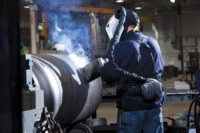My adventure took me to wonderful places: PEL Place, Toxicity Trail, Dichlorodifluoromethane Avenue, and the like. Why people should be using respiratory protection became clearer, so I asked how it was used, who was using it, and why.
These questions led me down Resistance Road. “Do you have any idea how much it will cost to enclose that painting process?” exclaimed the shirts and ties that looked at the bottom line.
Like most professionals intent on spreading the word about respiratory protection, I needed to lay the groundwork for a respiratory protection program. To do this, I first had to find out what makes it so difficult to begin with, how to overcome resistance, and learn the most essential information about the need for respiratory protection. In this article, I hope to bring this information to you.
What makes it difficult?
What is it exactly that makes respiratory protection issues so difficult? Could it be that the technology does not exist? It can’t be that because systems that enclose the process, evacuate and capture the contaminant, scrub the exhaust, and all but complete the disposal paperwork do exist.Perhaps it is the absence of specific respiratory protective devices. That’s a laugh. The choice of half- and full-face, hoods, partial- and full-helmet devices; no-, low-, limited- and full-maintenance types; loose- and tight-fitting; negative- and positive-pressure, powered air-purifying, pressure demand; filtering, air-purifying, atmosphere-supplying; routine use and escape-only; specific contaminant, concentration, and physical state pre-filters, filters, and cartridges is almost overwhelming. Perform a search on the Internet and depending upon the search engine of your choice, the results for “respirators” will set you up for no less than 87 years of reading, mouse clicking, and repetitive trauma injury (but that’s another matter in itself).
Could it be the absence of the commitment of safety and health professionals? The answer to this should be immediate and resounding. If you hesitated, shame on you.
Defeating ignorance
There are a multitude of stumbling blocks that you will encounter when attempting to address the respiratory protection issue. From my experience, they all fit into one category: ignorance.I know it sounds simple, but the absence of ignorance is key to the solution. If you do not know what it is, how it can harm and why, then you cannot sell management on the costs, the workers on the protection, or yourself in the job market.
The mantra of industrial hygiene is, “the anticipation, recognition, evaluation, and control of environmental factors arising in or from the workplace that may result in injury, illness, impairment, or affect the well-being of workers and members of the community.” However, you cannot anticipate if you know nothing of chemistry or toxicology, nor can you recognize, evaluate or subsequently control.
Workplace culture
Now think about the culture that exists in your workplace. “Respiratory protection doesn’t have to consider behavioral sciences or business management, does it?”, you may ask. Pardon me for a moment. I will answer that as soon as I get up off the floor, catch my breath, and work the cramp out of my stomach from laughing so hard. Unfortunately for many, the lessons to be learned in safety and health point them to other professions, including behavioral sciences and business management. I guess it’s better than a life of crime (AKA: professional liability).The essentials
The only way to address the respiratory protection issues that concern the health of your workplace environment is to know:- What is in the breathing zone;
- The physical state(s);
- The concentrations (peaks and average);
- The harmful effects;
- The suggested and recommended exposure levels (the OSHA PELs were established a very long time ago and have not kept pace with current medical information; look to the ACGIH levels for guidance);
- How it gets into the breathing zone, and
- Is the process that generates the exposure formalized or a “just get it done” activity?
All of the above require professional sampling, including samples taken over a full shift, during multiple shifts, according to established methods using specific equipment, analyzed by a professional laboratory facility, and having the results read by someone knowledgeable.
The use of lesser sampling methods may not (more likely, will not) give you the information needed to make the decisions involving capital costs, administrative controls, or the prescribing of personal protective equipment.
With the sampling complete, your task becomes even more daunting. Now you must address management controls; which forms of protective devices to prescribe; the use, care and service maintenance of the protective devices; educating and training management, supervisors, and users; employee acceptance of the protective devices; the supervision of the processes and employees, and the list goes on.

